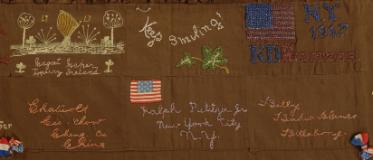The Eleventh Hour of the Eleventh Day of the Eleventh Month: World War I Quilts
Over 4,734,991 Americans had served in World War I. Today, traveling across the landscapes of France, Italy and the Low Countries, small fenced cemeteries remind us of the sacrifice of Americans made in the "Great War."
Quilts made between 1914 and 1918 are not as diverse as quilts made during the World War II years. Most are pieced Turkey Red and white or embroi- dered Redwork quilts. Wool quilts were also very popular. Newspapers during the war years did not record much quilting activity for the war effort until 1917 and 1918. The quilts reported on were made for fundraising for the Red Cross. World War I quilts are considered scarce and rare to find in the marketplace. A few can occasionally be found in museums and historical societies.
The Centennial Memorial of World War I will occur in 2014 to 2018. To date, this collection of World War I quilts numbers ten. It is available for exhibit to honor the 100th Commemoration of World War I from 2014-2018. Please contact Sue Reich at suereich@charter.net for further details.
This World War I quilt is comprised of Gold Star and blue Star Service Flags embroidered on wool rectangles. The quilt is tied with red wool yarn. The Gold Star Flag represent a soldier who was killed in action. The Blue Star Flag represents a soldier who was deployed.
This World War I Quilt is dated 1917-1918 from Denver, Colorado. There are approximately 400 names inscribed on the patriotic quilt from “The Great War.” Gold Stars are next to the names of men who were killed in World War I. In one section of the quilt are blocks signed Carrie Nation and Frances E. Willard important names in the WCTU. Herbert Hoover is also inscribed on the quilt.


Ohio, Army Captain Robert Quissner designed the Blue Star Service Flag during World War I while his sons were deployed to the battlefront. When the war ended, President Woodrow Wilson declared the Blue Star Mothers and Gold Star Mothers as national organizations.


Dated 1917, this World War I Signature Quilt has names from both the United States, England, Ireland, Canada, Italy, the West Indies, Sweden, Bermuda, France, Tasmania, and Scotland. It was possibly made as part of fundraising activity.


In December, 1917, Modern Priscilla Magazine responded to President Wilson's call for in-creased fund raising for the war effort. The magazine encouraged a Quilt Campaign be conducted using the Red Cross pattern in order to raise approximately $1,000 for the purchase of ambulances, emergency equip-ment and yarn for the war effort. The pattern was created by Clara Washburn Angell. By paying a small sum of money, your name would be signed of the quilt. The quilt would then be raffled to increase the monetary take. This is the most common World War I quilt to be found. Quilt documentation projects across the country found examples of this design in their research. The quilt shown here was made in Rutland, Vermont.
Early Twentieth Century artist, Rosie O'Neill's began to create and publish her precious Kewpie embroideries in 1914 at the onset of World War I. The designs often feature World War I doughboy figures. The quilt above is cot-size with a printed patchwork check in the alternating block.
In 1919, this Red Cross Fundraising Quilt was made in East St. Louis, Illinois. People would pay money to have their names signed on the quilt. The quilt was often then raffled as a double fund raiser. Soldiers from the war have Red Stars next to their names. Those who were killed in the war are honored with Gold Stars.



Flag flannels of many countries were given away with the purchase of cigars during the World War I era. Many quiltmakers used these decorative textiles to create quilts or tied comforts.


Dated Xmas 1918, this wool quilt is typical of quilts made during World War I. Wool was a popular textile choice in quiltmaking in the early 20th Century.